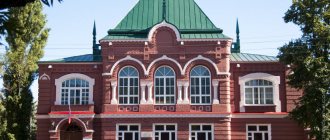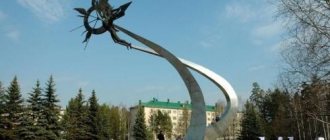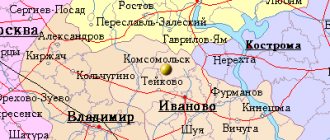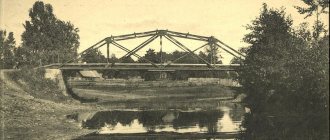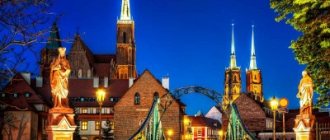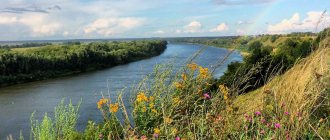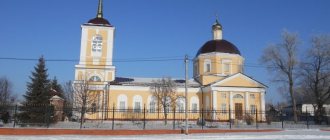| City | |
| Barysh | |
| Flag | Coat of arms |
Moscow
Ulyanovsk
Barysh
Barysh
Media files on Wikimedia CommonsThis term has other meanings, see Barysh.
Barysh
- a city of regional subordination in Russia, the administrative center of the Baryshsky district of the Ulyanovsk region and the Baryshsky urban settlement.
The city is located on the Barysh River (a tributary of the Sura) (Volga basin) and the Machkaleyka River, 139 km from Ulyanovsk. The city stretches from northwest to southeast for almost 9 kilometers.
Story
Background
The future city was formed from the merger of three settlements: the village of Troitskoye-Kuroedovo, the workers’ village of the Guryev cloth factory and the village of the Maryinsk stationery factory[3].
Village Troitskoye Kuroyedovo also
[4] founded at the end of the 17th century during the construction of the Syzran serif line (1683).
At the same time, the village of Guryevka .
With the founding of the villages, they became part of the Sinbirsky district of the Order of the Kazan Palace. [Map 1792]
From 1708 - in the Sinbir district of the Kazan province (1708-1781).
In 1754, in the village of Kuroyedovo (Troitskoye), parishioners built a stone church. There are two thrones in it: the main one (cold) - in the name of the Life-Giving Trinity and in the refectory chapel (warm) - in honor of the Dormition of the Mother of God[5].
In 1780, with the creation of the Simbirsk governorship, the villages became part of the Kanadeysky district.[6] Since 1796 - in Karsun district of Simbirsk province.
In 1826, in the village of Guryevka, landowner D.S. Krotkov built a cloth factory. In 1869, this factory was bought by the merchant Akchurin. The textile industry began to develop.
In 1848, landowner F. M. Koralsky founded a paper factory in the village of Troitskoye (Kuroedovo)[7], and in the village of Guryevka two factories were already operating: a paper and a cloth factory. Distillery[8].
In 1871, the factory passed into the hands of the merchant S. Maryin. The surrounding forests became an excellent raw material for paper production.
By the end of the 19th century, in the first quarter of the 20th century, there was a Guryevsky factory district, which included 4 cloth factories: Akchurina (Guryevka), Protopopova (Rumyantsevo), Shatrova (Izmailovo), Belousova (Bazarny Syzgan). Back then, in the peasant province of Simbirsk, the Guryevsky district was the main industrial area.
In 1900, there were parishioners in the villages that would be part of Barysh: in the village. Kuroyedov (n.r.) lived in 129 courtyards: 442 m. and 420 women; in the village Guryevka (n.r.) lived in 141 courtyards: 478 men. and 451 women; in the village Silaevka (n. r.) lived in 56 courtyards: 195 m. and 208 women; in total in 358 yards: 1212 m. and 1181 women; In addition, schismatics lived in 6 courtyards: 11 m. and 12 f. There were three schools: zemstvo in the village. Kuroyedov, zemstvo in the village. Guryevka and the church literacy school in the village. Silaevka (since 1899, housed in its own building)[5].
During the construction of the Moscow-Kazan Railway, which began in 1895 and ended in 1898, the Barysh railway station appeared near the village of Troitskoye Kuroyedovo, and the Akchurin crossing appeared near Guryevka.
During the first Russian revolution, Guryevka became one of the centers of the labor movement. The main strike committee was located here. The cloth factory workers were supported by the peasants of the surrounding villages. On August 31, 1906, the workers put up decisive resistance to government troops and they retreated to the village. Zhadovka. Only when up to a thousand soldiers were gathered in Guryevka was the uprising of workers and peasants suppressed.
In 1913, the villages that would later become part of the city of Barysh were: the village of Guryevka (cloth factory of T.K. Akchurin, public mill), village. Silaevka (Chas., school), village. Silaevsky Vyselok, village of Troitskoye Kuroyedovo (Church, school, station "Barysh", general chalk), Akchurins' cloth factory, near the village. Guryevka (sawmill, soap maker, cast iron plant), Maryina stationery factory, near the village. Trinity Kuroyedovo.[9]
In June 1917, a congress of a delegation of cloth factories was held in Guryevka - representatives of 26 factories of Simbirsk, Samara, Penza and Tambov provinces gathered. A trade union of textile workers was created[3].
On November 15, 1917, Soviet power was established at the Guryev Cloth Factory[3].
Barysh city
In 1918, a village council was created in Guryevka, which included: Guryevka, Guryevskaya cloth factory, Commune “Svet”, Silaevka and Silaevskie settlements, village. Yuryevsky. In Troitsko-Kuroedovsky s/s: s. Troitskoye Kuroyedovo, Baryshskaya paper mill, village. Springs[10].
On July 15, 1928, with the formation of the Syzran district of the Middle Volga region and its districts, the village of Troitsko-Kuroedovo with other villages included in the Barysh village council, the former Vodoratsk volost of the Karsun district, was renamed the village of Barysh
, which became the regional center of the Baryshsky district.
In 1930, the Baryshsky s/s included: s. Troitskoye Kuroyedovo, village. Vodokachka, village. Springs, Trepeln. plant, Faculty named after. Vorovsky. The Guryevsky s/s included: s. Guryevka, village Silaevka, pos. Silaevskie settlements[11].
On December 22, 1954, by Decree of the Presidium of the Supreme Soviet of the RSFSR, the workers' villages of Barysh and Guryevka were united into the city of Barysh of district subordination.
On November 6, 1975 it received the status of a city of regional subordination.
In 2004, the municipality “city of Barysh” was created.
According to the results of a referendum[12][13] held in 2008, the city of Barysh from January 1, 2009[14] from a city of regional significance was transformed into a city of district significance[15]. At the same time, the municipal formation “city of Barysh” changed its status from an urban district to an urban settlement and the territory of the city of Barysh became part of the Barysh municipal district.
Barysh
(Ulyanovsk region)
OKATO code:
73204501
Founded:
1954
City since:
1954 City of district subordination (Baryshsky district, Ulyanovsk region)
Center:
Baryshsky district
Telephone code (reference phone)
| 84253***** | 21-2-12 |
Deviation from Moscow time, hours:
1
Geographic latitude:
53°39′
Geographic longitude:
47°07′
Altitude above sea level, meters:
190 Sunrise and sunset times in the city of Barysh
Population
| Population | ||||||||
| 1959[16] | 1967[17] | 1970[18] | 1979[19] | 1989[20] | 1992[17] | 1996[17] | 1998[17] | 2000[17] |
| 17 909 | ↗19 000 | ↗20 792 | ↘20 288 | ↘20 213 | ↗21 300 | ↗21 900 | ↘21 600 | ↘21 300 |
| 2001[17] | 2002[21] | 2003[17] | 2005[17] | 2006[17] | 2007[17] | 2008[17] | 2009[22] | 2010[23] |
| ↘21 000 | ↘18 902 | ↘18 900 | ↘18 100 | ↘17 900 | ↘17 600 | ↘17 400 | ↘17 343 | ↘17 149 |
| 2011[17] | 2012[24] | 2013[25] | 2014[26] | 2015[27] | 2016[28] | 2017[29] | 2018[30] | 2019[31] |
| ↘17 100 | ↘16 931 | ↘16 848 | ↘16 608 | ↘16 431 | ↘16 275 | ↘16 147 | ↘15 974 | ↘15 759 |
| 2020[32] | 2021[1] | |||||||
| ↘15 541 | ↘15 408 | |||||||
As of January 1, 2022, in terms of population, the city was in 766th place out of 1,116[33]cities of the Russian Federation[34].
Economy
- Worsted Association "October"
- Flour mill (inactive)
- Bakery,
- Poultry farm "Elkhovskaya" (inactive)
- Paper mill, (inactive)
- Barysh clothing factory
- Cloth (Baryshskaya) factory named after Gladyshev (closed in 2005)[35][36]
- Furniture factory "Baryshmebel", (inactive)
- ,
- Barysh metal roofing plant
- Barysh asphalt plant
- Enterprises producing building materials and food. The Kuibyshev Railway runs through the city.
Trade
The following retail chains operate in the city:
- Auto shop "Canister"
- Baryshskoe raipo
- "Magnet"
- "Pyaterochka"
- Communication salon "MTS"
- Communication salons "DIXIS"
- Format
- "Victory"
Trading
Banks
- "Sberbank"
- "Bank Venets"
- Rosselkhozbank
Attractions
- The Trinity Church (1754) has survived[43].
- In the vicinity of Barysh, in the upper reaches of the Malaya Sviyaga River, there is the Akshuat Arboretum, in which pine trees, thujas, blue spruce trees, and larches grow.
- In the suburb of Barysh, in the village of Novy Dol, the count's estate of Countess Alexandra Feodorovna Tolstoy[44], which is more than 100 years old, has been preserved. And also a park that is more than 100 years old[45], but due to the inaction of local government, it is not maintained.
- Forest blocks from 13 to 21 of the Barysh forestry [46].
- Monument to soldiers who died during the Great Patriotic War[47].
- Memorial complex - square of the 40th anniversary of Victory in the Great Patriotic War[47].
Excerpt characterizing Barysh (city)
“Be quiet, Petya, what a fool you are!” “I’m not a fool, but those who cry over trifles are fools,” said Petya. – Do you remember him? – after a minute of silence Natasha suddenly asked. Sonya smiled: “Do I remember Nicolas?” “No, Sonya, do you remember him so well that you remember him well, that you remember everything,” Natasha said with a diligent gesture, apparently wanting to attach the most serious meaning to her words. “And I remember Nikolenka, I remember,” she said. - I don’t remember Boris. I don’t remember at all... - How? Don't remember Boris? – Sonya asked in surprise. “It’s not that I don’t remember, I know what he’s like, but I don’t remember it as well as Nikolenka.” Him, I close my eyes and remember, but Boris is not there (she closed her eyes), so, no - nothing! “Ah, Natasha,” said Sonya, looking enthusiastically and seriously at her friend, as if she considered her unworthy to hear what she had to say, and as if she were saying this to someone else with whom one should not joke. “I once fell in love with your brother, and no matter what happens to him, to me, I will never stop loving him throughout my life.” Natasha looked at Sonya in surprise and with curious eyes and was silent. She felt that what Sonya said was true, that there was such love as Sonya spoke about; but Natasha had never experienced anything like this. She believed it could be, but she didn't understand. -Will you write to him? – she asked. Sonya thought about it. The question of how to write to Nicolas and whether to write and how to write was a question that tormented her. Now that he was already an officer and a wounded hero, was it good of her to remind him of herself and, as it were, of the obligation that he had assumed in relation to her. - Don't know; I think if he writes, I’ll write too,” she said, blushing. “And you won’t be ashamed to write to him?” Sonya smiled. - No. “And I’ll be ashamed to write to Boris, I won’t write.” - Why are you ashamed? Yes, I don’t know. Embarrassing, embarrassing. “And I know why she will be ashamed,” said Petya, offended by Natasha’s first remark, “because she was in love with this fat man with glasses (that’s how Petya called his namesake, the new Count Bezukhy); Now she’s in love with this singer (Petya was talking about the Italian, Natasha’s singing teacher): so she’s ashamed. “Petya, you’re stupid,” Natasha said. “No more stupid than you, mother,” said nine-year-old Petya, as if he were an old foreman. The Countess was prepared by hints from Anna Mikhailovna during dinner. Having gone to her room, she, sitting on an armchair, did not take her eyes off the miniature portrait of her son embedded in the snuffbox, and tears welled up in her eyes. Anna Mikhailovna, with the letter, tiptoed up to the countess's room and stopped. “Don’t come in,” she said to the old count who was following her, “later,” and closed the door behind her. The Count put his ear to the lock and began to listen. At first he heard the sounds of indifferent speeches, then one sound of Anna Mikhailovna's voice, making a long speech, then a cry, then silence, then again both voices spoke together with joyful intonations, and then steps, and Anna Mikhailovna opened the door for him. On Anna Mikhailovna's face was the proud expression of an operator who had completed a difficult amputation and was introducing the audience so that they could appreciate his art. - C'est fait! [The job is done!] - she said to the count, pointing with a solemn gesture at the countess, who was holding a snuffbox with a portrait in one hand, a letter in the other, and pressed her lips to one or the other. Seeing the count, she stretched out her arms to him, hugged his bald head and through the bald head again looked at the letter and portrait and again, in order to press them to her lips, she slightly pushed the bald head away. Vera, Natasha, Sonya and Petya entered the room and the reading began. The letter briefly described the campaign and two battles in which Nikolushka participated, promotion to officer, and said that he kisses the hands of maman and papa, asking for their blessing, and kisses Vera, Natasha, Petya. In addition, he bows to Mr. Sheling, and Mr. Shos and the nanny, and, in addition, asks to kiss dear Sonya, whom he still loves and about whom he still remembers. Hearing this, Sonya blushed so that tears came to her eyes. And, unable to withstand the glances directed at her, she ran into the hall, ran up, spun around and, inflating her dress with a balloon, flushed and smiling, sat down on the floor. The Countess was crying. -What are you crying about, maman? - Vera said. “We should rejoice at everything he writes, not cry.” This was completely fair, but the count, the countess, and Natasha all looked at her reproachfully. “And who did she look like!” thought the Countess. Nikolushka's letter was read hundreds of times, and those who were considered worthy of listening to it had to come to the countess, who would not let him out of her hands. Tutors, nannies, Mitenka, and some acquaintances came, and the countess re-read the letter every time with new pleasure and each time, from this letter, she discovered new virtues in her Nikolushka. How strange, extraordinary, and joyful it was for her that her son was the son who had barely noticeably moved with tiny limbs inside her 20 years ago, the son for whom she had quarreled with the pampered count, the son who had learned to say before: “ pear,” and then “woman,” that this son is now there, in a foreign land, in a foreign environment, a courageous warrior, alone, without help or guidance, doing some kind of manly work there. All the world's centuries-old experience, indicating that children imperceptibly from the cradle become husbands, did not exist for the countess. The maturation of her son in every season of manhood was as extraordinary for her as if there had never been millions of millions of people who matured in exactly the same way. Just as she couldn’t believe 20 years ago that that little creature that lived somewhere under her heart would scream and begin to suck her breast and start talking, so now she couldn’t believe that this same creature could be that strong, a brave man, an example of the sons and men he was now, judging by this letter.
Famous people
- Nedviga, Yuri Dmitrievich
- Priest Alexander Mikhailovich Kerensky (uncle - Kerensky, Alexander Fedorovich) served in the church of the village. Kuroyedovo from 1857 to 1881 (now the town of Barysh). There are methodological books in the State Educational Institution. Kuroyedovo from the second half of the 19th century[49].
- Khusain Asadulovich Aipov is a revolutionary, born in the village of Guryevka, Karsun district (now part of Barysh)[50].
- Gismatullina, Hanifa - Tatar educator, pedagogical theorist, one of the first Tatar poetesses [51] Her main works were published during the years of work in the women's mekteb (school) in the village of Guryevka (now part of Barysh) (1890-1898)
- Simonova, Anna Stepanovna - Hero of Socialist Labor, weaver at the factory named after. Gladysheva, Baryshsky district.
- Barykov, Gennady Ivanovich - Hero of the Soviet Union (06/29/1945), studied at a local school.
- Borisov, Boris Stepanovich - Hero of the Soviet Union (1943), lived in Barysh.
Barysh and its attractions.
The small Volga region town of Barysh in the Ulyanovsk region settled in the Volga River basin. The first settlements appeared here about three hundred years ago. In the 17th-18th centuries, glass factories, distilleries and numerous cloth factories were built on this land. By the end of the 19th century, there were already operating here: Guryevskaya, Rumyantsevskaya and two Starotimoshkinsky cloth factories, which are successfully operating to this day. It was thanks to the weaving industry that the city developed economically. Traveling through the amazing corners of our homeland, we don’t always know which apartments are best for us to stay in. Today this is no longer a problem - rent apartments for daily rent in Barysh and enjoy your vacation!
This region has amazing nature! The sources of the Sura, Syzranka, Barysha, Bekshanka rivers, dense forests, beautiful lakes and springs - here you can simply dissolve in the amazing landscapes... The main natural attraction of the area is the stunning Akshuatsky Park. This arboretum was founded at the end of the 19th century. It is located in the vicinity of the village of Akshuat and is a protected area. Blue spruces, pines, thujas, larches and other trees and shrubs grow here. The park was founded by an outstanding public figure of the Simbirsk province, Vladimir Polivanov. He was the chairman of the Simbirsk provincial scientific archival commission and the owner of an estate near the village of Akshuat.
Another unique attraction of Barysh is the stone Trinity Church, built in the 18th century. During its existence, the temple was rebuilt several times; today it is open to all believers. And in the village of Zhadovka, Barysh district, there is the Zhadovskaya Hermitage, known throughout Russia, where the Kazan-Bogoroditsky Monastery was built at the end of the 17th century.
Notes
- ↑ 12
The permanent population of the Russian Federation by municipalities as of January 1, 2022 (Russian). Retrieved April 27, 2022. Archived May 2, 2022. - Gorodetskaya I. L., Levashov E. A.
Barysh // Russian names of residents: Dictionary-reference book. - M.: AST, 2003. - P. 41. - 363 p. — 5000 copies. — ISBN 5-17-016914-0. - ↑ 1 2 3
History - Administration of the municipal district "Baryshsky district"
(unspecified)
. barysh.org. Date accessed: April 9, 2022. - “The temple is made of stone, built by parishioners in 1754. There are two thrones in it: the main one (cold) in the name of the Life-Giving Trinity and in the refectory chapel (warm) in honor of the Dormition of the Mother of God.” 585. p.
Kuroyedovo (Troitskoye) at the river. Sar-Baryshe (for 1900) https://archeo73.ru/Russian/20vek/bajenov/carsun.htm - ↑ 1 2
N. Bazhenov.
Statistical description of cathedrals, monasteries, parish and house churches of the Simbirsk diocese according to data from 1900. Karsun district / No. 585 - p. Kuroyedovo (Troitskoye) (Russian). archeo73.ru
. Access date: April 12, 2022. - The village of Troitskoye Kuroyedovo, also, landowner peasants - No. 64, Village Guryevka, and the inhabitants in it are listed according to the audit in the village of Troitsky Kuroyedovo - No. 65 //.
Creation of the Simbirsk governorship.
Kanadeysky district. 1780 (undefined)
. archeo73.ru. Date accessed: April 9, 2022. - No. 869 - Troitskoye (Kuroedovo) /.
Simbirsk province 1859 Karsun district
(unspecified)
. archeo73.ru. Date of access: April 8, 2022. - No. 870 - village of Guryevka /.
Simbirsk province 1859 Karsun district
(unspecified)
. archeo73.ru. Date of access: April 8, 2022. - N.P. InfoRost //.
GPIB |
List of populated places in Simbirsk province. [1913. - Simbirsk, 1913.] (undefined)
. elib.shpl.ru. Date accessed: April 9, 2022. - N.P. InfoRost //.
GPIB |
List of populated places in Ulyanovsk province. - Ulyanovsk, 1924. (unspecified)
. elib.shpl.ru. Date accessed: April 9, 2022. - No. 564 - Baryshsky s/s, No. 586 - Guryevsky s/s.
/. SNP S-Volzh.
region for 1931 / (undefined)
. - Results of the Referendum on June 1, 2008 in the Barysh district
- Results of the Referendum on June 1, 2008 for the city of Barysh
- Law of the Ulyanovsk region dated June 26, 2008 No. 104-ZO “On the transformation of the municipal formation “city of Barysh” and on amendments to certain legislative acts of the Ulyanovsk region”
- Ulyanovsk region: Governor and Government (unspecified)
(inaccessible link). Access date: May 25, 2010. Archived August 4, 2009. - All-Union Population Census of 1959. The size of the urban population of the RSFSR, its territorial units, urban settlements and urban areas by gender (Russian). Demoscope Weekly. Access date: September 25, 2013. Archived April 28, 2013.
- ↑ 123456789101112
People's encyclopedia "My City". Barysh (city) - All-Union Population Census of 1970 The size of the urban population of the RSFSR, its territorial units, urban settlements and urban areas by gender. (Russian). Demoscope Weekly. Access date: September 25, 2013. Archived April 28, 2013.
- All-Union Population Census of 1979 The size of the urban population of the RSFSR, its territorial units, urban settlements and urban areas by gender. (Russian). Demoscope Weekly. Access date: September 25, 2013. Archived April 28, 2013.
- All-Union population census of 1989. Urban population (undefined)
. Archived from the original on August 22, 2011. - All-Russian population census 2002. Volume. 1, table 4. Population of Russia, federal districts, constituent entities of the Russian Federation, districts, urban settlements, rural settlements - regional centers and rural settlements with a population of 3 thousand or more (unspecified)
. Archived from the original on February 3, 2012. - The size of the permanent population of the Russian Federation by cities, urban-type settlements and regions as of January 1, 2009 (unspecified)
. Retrieved January 2, 2014. Archived January 2, 2014. - All-Russian population census 2010. Settlements of the Ulyanovsk region and the size of the population living in them by age (unspecified)
. Retrieved May 14, 2014. Archived May 14, 2014. - Population of the Russian Federation by municipalities. Table 35. Estimated resident population as of January 1, 2012 (unspecified)
. Retrieved May 31, 2014. Archived May 31, 2014. - Population of the Russian Federation by municipalities as of January 1, 2013. - M.: Federal State Statistics Service Rosstat, 2013. - 528 p. (Table 33. Population of urban districts, municipal districts, urban and rural settlements, urban settlements, rural settlements) (undefined)
. Retrieved November 16, 2013. Archived November 16, 2013. - Table 33. Population of the Russian Federation by municipalities as of January 1, 2014 (unspecified)
. Access date: August 2, 2014. Archived August 2, 2014. - Population of the Russian Federation by municipalities as of January 1, 2015 (unspecified)
. Access date: August 6, 2015. Archived August 6, 2015. - Population of the Russian Federation by municipalities as of January 1, 2016 (Russian) (October 5, 2018). Retrieved May 15, 2022. Archived May 8, 2022.
- Population of the Russian Federation by municipalities as of January 1, 2022 (Russian) (July 31, 2017). Retrieved July 31, 2022. Archived July 31, 2022.
- Population of the Russian Federation by municipalities as of January 1, 2022 (Russian). Retrieved July 25, 2018. Archived July 26, 2022.
- Population of the Russian Federation by municipalities as of January 1, 2022 (Russian). Retrieved July 31, 2019. Archived May 2, 2022.
- Population of the Russian Federation by municipalities as of January 1, 2022 (Russian). Date accessed: October 17, 2022. Archived October 17, 2022.
- taking into account the cities of Crimea
- https://rosstat.gov.ru/storage/mediabank/bul_Chislen_nasel_MO-01-01-2021.rar Population of the Russian Federation by municipalities as of January 1, 2022 (1.85 Mb, 07/30/2021)
- Since 1965 - Cloth factory named after Gladyshev of the Ulyanovsk association of woolen enterprises of the 2nd Main Directorate of the Wool Industry of the Ministry of Light Industry of the RSFSR, Barysh, Barysh district, Ulyanovsk region - Fund No. R-3137 GAUO (unspecified)
.
ogugauo.ru
. Access date: June 25, 2022. - Disappeared enterprises of the USSR. Barysh factory named after. Gladysheva (1825–2005) (Russian). Yandex Zen |
Platform for authors, publishers and brands . Access date: June 25, 2022. - https://barysh.org/city/transport/vokzal/deistv_raspis_elektropoezda_s_29_05_16.pdf (inaccessible link) Current schedule of suburban trains "Inza - Syzran" from 05/29/2016.
- https://barysh.org/city/transport/vokzal/svod_rasp_BGP_2016_2017.pdf (inaccessible link) SUMMARY SCHEDULE of route buses on the territory of the municipality "Barysh urban settlement" in the autumn - winter period 2016-2017
- https://barysh.org/city/transport/reestr_17_03_17.pdf
- https://barysh.org/city/transport/vokzal/svod_rasp_BR_2016_2017.pdf (inaccessible link) SUMMARY SCHEDULE of bus traffic on regular intra-municipal bus routes on the territory of the Baryshsky district municipal district in the autumn-winter period 2016-2017.
- Educational organizations located on the territory of the municipal formation "Baryshsky District" (inaccessible link)
- List of regional state educational institutions of primary and secondary vocational education, subordinate to the Ministry of Education and Science of the Ulyanovsk Region (inaccessible link)
- No. 585. p.
Kuroyedovo (Troitskoye) at the river. Sar-Baryshe /. N. Bazhenov.
Statistical description of cathedrals, monasteries, parish and house churches of the Simbirsk diocese according to data from 1900. Karsun district. (undefined)
. archeo73.ru. Date accessed: April 9, 2022. - subuloff.
Countess Alexandra Feodorovna Tolstaya and her estate in Staraya Zinovyevka, Karsun district.
(undefined)
.
subuloff
(August 3, 2013). Access date: July 10, 2022. - The Iron Lady from Novy Dol (Russian). Ulpressa
. Access date: July 10, 2022. - Forest blocks from 13 to 21 of the Barysh forestry with a predominance of valuable medicinal raw materials | Protected natural areas of Russia (unspecified)
.
oopt.aari.ru.
_ Access date: August 30, 2022. - ↑ 1 2 admin.
Baryshsky district | “Cranes of our memory...” (Russian). Access date: October 22, 2022. - License revoked (undefined)
. - History - Administration of the municipal district "Baryshsky district" (unspecified)
. barysh.org. Date accessed: April 9, 2022. - Khusain Asadullovich Aipov / (unspecified)
. - Kharrasova R.F. Uylar Tukaiga ilta. – Kazan: IYALI, 2016. – b. 127 ISBN 978-5-93091-196-1 (Tatar.)
Sights of the city of Barysh (Ulyanovsk region)
The material “In the Ulyanovsk region there is a water tower as a monument”, published by Main News of Ulyanovsk on August 15, evoked a response from readers from the Baryshsky district.
Let us remember that we were talking about an ancient tower of the 19th century, located on Fabrichnaya Street in the regional center. Recently, this structure has come to the attention of the Department of Cultural Heritage of the Ulyanovsk Region and the issue of including the tower in the register of identified objects of cultural significance is being decided. The residents of Barysh were certainly pleased to know that the tower had received attention - for many decades it was simply abandoned and was slowly collapsing. So, the water tank had long since been dismantled, the stairs leading up to the top were broken, and the entire wooden part of the structure was pretty dilapidated. If the tower is recognized as a cultural heritage site, it could be restored and become a real highlight of the area. Because, according to old-timers, it is the same age as the legendary Eiffel Tower and deserves to be preserved for posterity.
Attractions But in addition to the water tower, on the same Fabrichnaya Street there are at least two more interesting objects worthy of the attention of tourists. The first is the estate of the Akchurin factory owners, also built at the turn of the last century. A few years ago there was a clinic there, but after the notorious optimization the house turned out to be abandoned. The walls, floors and ceilings are well preserved (they were built centuries earlier), and if desired, a museum of Russian entrepreneurs could be created there.
By the way, next to the estate there is a small pond called Bolnichny by Baryshtsy, which could also be improved, and it would ideally complete the image of the historical reserve. In Soviet times, by the way, the pond was a favorite swimming place for local children; there were even bridges and springboards there. Alas, in the 1990s everything was abandoned and gradually collapsed.
The Akchurins were the owners of a textile factory, the former factory named after Gladyshev, which (and this is a historical fact) was founded in 1826 and is the oldest enterprise in the industry in the entire Middle Volga region! Moreover, in the middle of the 19th century, the entire south of the Simbirsk province was called nothing less than the Guryevsky industrial region (in the 1940s, the village of Guryevka became part of Barysh). Of course, now only a couple of old buildings remain from the former factory building, which, nevertheless, give an idea of the factory architecture of that time.
In light of the course taken by the regional authorities to transform the Ulyanovsk region into an international tourism destination, we hope that close attention will be paid to the Barysh monuments. There are not many attractions in our region to waste. Evgeniy MIKHAILOV Photo by the author
The war seriously undermined the economy of the Barysh region and claimed the lives of 8 thousand front-line soldiers. On June 22, 1941, in villages and workers' settlements, a government message about the treacherous attack of Nazi Germany on our country was received by radio. Hundreds of businessmen came to the military registration and enlistment office.
Nine people connected by various life circumstances with the Baryshsky district were awarded the high title of Hero of the Soviet Union. Among them are natives of the village. Old Timoshkino - commander of the motorized rifle brigade, Colonel Khamzya Salimovich Bogdanov, battery commander, junior lieutenant Abdulhak Sagitovich Umerkin and sapper Ali Kasimovich Abdrezakov and others.
The 55th Marine Division and other military units have been formed in the Baryshsky region. Several training units were located here. The local station escorted train after train to the front, and received ambulance trains from the west. In Izmailovo, surrounded by a pine forest, a hospital was located. Those who died from wounds were buried in a common cemetery. Now a monumental sculpture has risen above the soldiers’ graves. A grieving mother mourns her sons. Every year, on May 9, townspeople and all residents of the area gather at the monuments of soldiers to honor their memory.
In the Baryshsky district there are 46 monuments and obelisks erected in memory of the feat of fellow countrymen who did not return from the fronts of the Great Patriotic War. Most monuments began to be erected in the year of the 25th anniversary of the Victory.
- Monuments and memorial sites dedicated to the Great Patriotic War of 1941-1945. in Baryshsky district
Source
